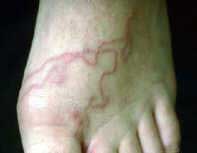According to a survey conducted by the Central Institute of Malariology, Parasitology, and Entomology, it is estimated that around 60 million people in our country are infected with roundworms, 40 million with whipworms, and 40 million with hookworms. Intestinal worm infections pose significant harm to humans and are a serious public health issue.
The progression of intestinal worm diseases varies greatly among different demographics (children, women, etc.) and depends on occupational factors. The severity of damage caused by intestinal worms can range from mild to severe, depending on the species of parasite, the number of worms present, their ability to consume nutrients, and their toxicity, as well as the individual’s susceptibility and tolerance to these worms.
 |
| Do not let children play in unsanitary areas to avoid intestinal worm infections. (Image: myweb) |
Regarding Roundworms
Clinical manifestations in individuals infected with roundworms are often subtle and typically only identified through stool tests or when adult worms are excreted with feces. The incidence of vomiting and passing worms is approximately 0.5% among individuals infected with roundworm eggs via the oral route. During the larval migration phase, when the roundworm passes through the lungs, some signs may appear, such as coughing, bronchial asthma, rashes, or abnormal coughing up of blood. If, for any reason, the roundworm larvae settle in the liver, brain, spinal cord, eyes, or kidneys, the damage they cause can be unpredictable. When adult worms parasitize the intestines in numbers of 5-6, symptoms may include “worm belly” pain with intermittent abdominal cramps. Heavy infections can lead to serious complications such as intestinal obstruction, with an incidence rate of 38-87.5%, and in these cases, the number of worms can exceed 60. Intestinal obstruction due to roundworms is most commonly observed in children (57.7%). Additionally, roundworms can cause severe complications such as enteritis, bowel perforation, cholangitis, gallstone formation, liver abscesses, or worms invading hollow cavities.
The damage caused by roundworms arises from their consumption of nutrients, particularly vitamin A, in the intestines for their growth and reproduction. They also secrete a substance called Ascaris that regularly causes toxicity to the body. In the digestive tract, roundworms constantly irritate and damage the intestinal mucosa, manifesting as hypertrophy or cell loss. Roundworms disrupt digestion and decrease the absorption of nutrients, negatively impacting fat and protein digestion in the intestines, leading to malnutrition, especially in children and pregnant women. Each day, 26 roundworms in the intestines can consume up to 4 grams of protein from the total 35-50 grams ingested. In children infected with roundworms, the body’s ability to absorb carbohydrates from rice decreases. If around 15 roundworms are present, the body may lose 13.4% of fat and 7.2% of protein from the daily diet, significantly affecting both the physical and mental development of the child.
Regarding Whipworms
If the infection is mild, there will be no clinical manifestations. In cases of heavy infection, the intestinal mucosa may be severely damaged and continuously stimulated, leading to symptoms such as nausea, abdominal pain, diarrhea, or a syndrome resembling dysentery (frequent bowel movements with blood and mucus). The rectal area may become inflamed and filled with worms. Heavy whipworm infection can lead to anemia syndrome.
Young individuals are often at risk of whipworm infections, which can lead to sleep disturbances, and prolonged cases may result in neurological disorders. In small children, whipworms can cause stunted growth and delayed intellectual development. Whipworms may also reside in the appendix or be responsible for introducing bacteria that cause appendicitis.
Hookworm Disease
 |
| The type of hookworm that enters the body through the skin (Image: scientificpsychic) |
These worms enter the body through the skin, tissue, or through the digestive system, migrating through the esophagus to the lungs. In first-time infections, the area of skin where larvae penetrate may exhibit allergic dermatitis, causing a phenomenon known as “ground itch.” In the duodenum, jejunum, or the proximal part of the small intestine, adult hookworms attach to the intestinal wall using hooks or sharp teeth. They burrow deep into the intestinal mucosa, causing ulcers, which, when infected with bacteria, may develop into large, ulcerated lesions. In the intestines, hookworms regularly suck nutrients, leading to iron depletion, reduced hemoglobin, and decreased levels of certain vitamins like A, B1, B2, C, and iron ions.
Clinical manifestations typically include digestive disorders, taste disturbances (poor appetite), nausea, loss of appetite, abdominal pain around the navel or in the epigastric region similar to peptic ulcer disease, and black stools mixed with blood. Patients often feel fatigued, work sluggishly, lose their appetite, and experience heaviness in the lower limbs while walking. A prominent symptom in individuals with hookworm infections is anemia. Anemia can become severe, particularly in children and pregnant women, and can lead to fatal outcomes. In addition to sucking blood, hookworms secrete substances that slow blood coagulation, causing prolonged blood loss. These toxins also destroy high-protein, fat, and carbohydrate foods, leaving patients devoid of energy and work capacity. Children may experience stunted growth, and pregnant women are at higher risk for miscarriage or stillbirth.
Prevention of Intestinal Worm Infections
– Use anthelmintic medications for treatment. Currently, several common anthelmintic drugs are effective in treating all three types of worms: levamisole (Decaris, Hacaris, etc.); mebendazole (Vermox, Fugacar, etc.); albendazole (Zentel, Alzental, etc.); and pyrantel pamoate (Combantrin, Anthel, etc.).
– Regularly conduct environmental sanitation to eliminate worm eggs and larvae during their development in the external environment (mainly in soil). Prevent the potential for reinfection by intestinal worms.
– Enhance communication and education efforts to raise public awareness about intestinal worm diseases, encouraging community participation in infection and reinfection prevention.
– Incorporate worm prevention into health sector action plans and strategies.
Dr. QUOC DONG


















































